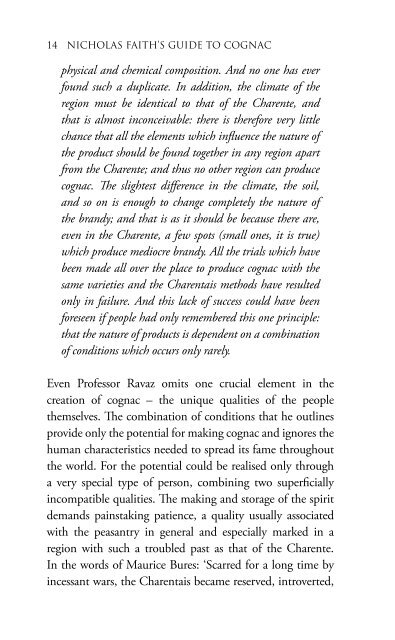Create successful ePaper yourself
Turn your PDF publications into a flip-book with our unique Google optimized e-Paper software.
physical and chemical composition. And no one has ever<br />
found such a duplicate. In addition, the climate of the<br />
region must be identical to that of the Charente, and<br />
that is almost inconceivable: there is therefore very little<br />
chance that all the elements which influence the nature of<br />
the product should be found together in any region apart<br />
from the Charente; and thus no other region can produce<br />
cognac. The slightest difference in the climate, the soil,<br />
and so on is enough to change completely the nature of<br />
the brandy; and that is as it should be because there are,<br />
even in the Charente, a few spots (small ones, it is true)<br />
which produce mediocre brandy. All the trials which have<br />
been made all over the place to produce cognac with the<br />
same varieties and the Charentais methods have resulted<br />
only in failure. And this lack of success could have been<br />
foreseen if people had only remembered this one principle:<br />
that the nature of products is dependent on a combination<br />
of conditions which occurs only rarely.<br />
Even Professor Ravaz omits one crucial element in the<br />
creation of cognac – the unique qualities of the people<br />
themselves. The combination of conditions that he outlines<br />
provide only the potential for making cognac and ignores the<br />
human characteristics needed to spread its fame throughout<br />
the world. For the potential could be realised only through<br />
a very special type of person, combining two superficially<br />
incompatible qualities. The making and storage of the spirit<br />
demands painstaking patience, a quality usually associated<br />
with the peasantry in general and especially marked in a<br />
region with such a troubled past as that of the Charente.<br />
In the words of Maurice Bures: ‘Scarred for a long time by<br />
incessant wars, the Charentais became reserved, introverted,<br />
discreet.’ 7 This combination was precisely the opposite of<br />
the open, adventurous, outlook required if cognac were to<br />
be marketed successfully the world over. Yet it was always<br />
destined chiefly for sale abroad, for the French market has<br />
never been a dominant factor.<br />
Their instinctive reluctance to allow anyone to intrude<br />
on their intensely private family life is symbolised by the<br />
apparently unwelcoming facade of the local buildings<br />
with their dour stone walls interrupted only by stout,<br />
permanently shut wooden doors that enclose spacious<br />
cobbled farmyards surrounded by fermentation vats, still<br />
rooms and storehouses. Outsiders find the blank stone<br />
walls sad and menacing; the inhabitants find them deeply<br />
reassuring. Cagouillards, snails, they are nicknamed, shut<br />
in their fortresses. This collective introversion, this native<br />
defensiveness, is not confined to the countryside but<br />
extends to the small country towns – like <strong>Cognac</strong> itself.<br />
Yet, miraculously, the inhabitants have managed to<br />
combine the two qualities. The fusion was best expressed by<br />
the region’s most distinguished native, the late Jean Monnet,<br />
the ‘founder of Europe’. He was the son of one of <strong>Cognac</strong>’s<br />
leading merchants, and he remembers how every evening ‘at<br />
dusk, when we lit the lamps, we had to shut every shutter.<br />
“They can see us,” my mother would say, so greatly did she<br />
share the anxiety, the fear of being seen, of exposure which is<br />
so marked a trait of the Charentais character.’ 8<br />
Yet in the Monnet household, as in that of many other<br />
merchants, guests were not exclusively aged aunts or<br />
7 Maurice Bures, ‘Le Type Saintongeais’, La Science Sociale, vol. 23<br />
(Paris, 1908).<br />
8 In Mémoires (Paris, 1976).


